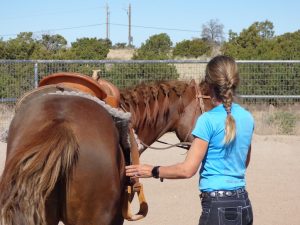
Ground work includes every aspect of you and your horse on the ground
Editor’s Note: Best Horse Practices Summit presenter Katrin Silva grew up riding dressage in Germany before moving to the United States at age 19 to learn to ride Western. She’s been riding both disciplines for the last twenty years and is a regular guest columnist for Cayuse Communications. She lives in New Mexico where she works with dressage and Western clients. Visit her blog here.
Katrin writes:
When I was younger, I worked mainly as a colt starter. I did not charge enough money because I didn’t think I was that good, which forced me to take on more horses than I had time for. As a result, I rushed through groundwork, reasoning that my clients paid me for time in the saddle. I spent just enough ground time with a green horse to get bucked off less often than I otherwise might have.
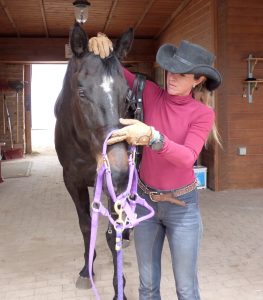
Haltering is ground work
Now older and wiser, I’ve changed my mind about groundwork. It’s not just because I don’t bounce as well as I used to. I meet lots of horses, even experienced riding horses, with bad ground manners:
- who drag behind or charge ahead while leading
- who don’t lead at all
- who have never learned how to stand tied
- who are pushy, hard to catch horses, or head-shy
- without clear boundaries.
- who won’t load
- who won’t give their feet.
These horses are not pleasant to be around. At worst, they are unsafe. I should know. I have a dental implant from getting head-slammed by such a horse. Of course, the behavioral issues exhibited on the ground tend to show up in their under-saddle work, too. Why wouldn’t they? I now think groundwork is time well spent. But I nonetheless disagree with some of the ideas out there:
“Once you can do something with your horse on the ground, you can get on and do it under saddle, no problem!”
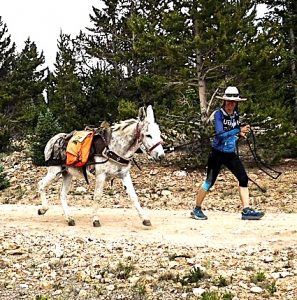
Katrin and friend compete in a pack burro race — also ground work!
Not exactly. Or, only to a point. Teaching your horse to follow direction and yield from pressure from the ground before you do it from the saddle is a good idea. Teaching your horse to respond to voice commands and body language is never wrong. Introducing a new movement like the rein back from the ground makes sense. Horses do connect these dots.
But from the saddle, you teach your horse to respond to your weight and seat and legs. You teach your horse the language of your back and you learn the language of his back. Carrying a rider changes the horse’s balance, which means the horse needs to re-learn any movement he already knows without a rider. Groundwork can support this process, but it’s not a substitute.
“ Doing lots of groundwork will make me a better rider.”
Yes and no. Doing groundwork will improve your relationship and can teach you about listening to a horse’s body language. It will reveal personality and training issues. But only lots of riding will make you a great rider.
Don’t get me wrong: you can build a beautiful relationship with your horse without ever being an accomplished rider. But riding well takes flexibility, coordination, sensitivity, core strength, the feedback of a good instructor or two. Above all, it takes lots and lots of practice in the saddle.
“I barely have enough time to ride! I can’t fit in extra time for groundwork!”
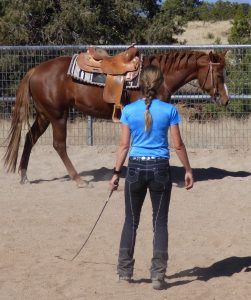 I know this one well because I hear myself thinking it all the time. The truth is, if your horse does not have serious issues, you don’t have to set aside extra time. You are doing groundwork before and after every ride: catching, haltering, leading, grooming, medicating, holding your horse for the farrier, etc. Every time you handle your horse, you are doing groundwork. You are teaching him something you want him to do, or something you don’t want him to do. It’s up to you to reinforce the best habits.
I know this one well because I hear myself thinking it all the time. The truth is, if your horse does not have serious issues, you don’t have to set aside extra time. You are doing groundwork before and after every ride: catching, haltering, leading, grooming, medicating, holding your horse for the farrier, etc. Every time you handle your horse, you are doing groundwork. You are teaching him something you want him to do, or something you don’t want him to do. It’s up to you to reinforce the best habits.
“Trainer X has the best groundwork method! I’ve gone to his clinic/watched his videos. I bought his online course/special halter/whip. He’s brilliant! Everyone should do it this way! It’s the only correct way.”
You don’t have to follow a particular trainer. You don’t have to use a specific method or use a specific piece of equipment. If you lack experience, it may be helpful to follow a program, but it’s not necessary. The best approach depends on your goals, the tools you’re comfortable using, and your equestrian background.
What’s important is that you are:
- Clear about the things you do and don’t want your horse to learn
- Able to read the horse’s body language and expression
- Calm in your movements, your voice, and your emotions.
- Consistent in your work.
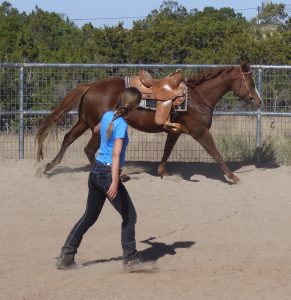 The horsewomen and horsemen I respect the most, the ones whose horses have excellent ground manners, don’t have much in common. Some wear jeans. Others wear breeches. Some use rope halters, others swear by lungeing cavessons. Some use flags. Some use whips or clickers.
The horsewomen and horsemen I respect the most, the ones whose horses have excellent ground manners, don’t have much in common. Some wear jeans. Others wear breeches. Some use rope halters, others swear by lungeing cavessons. Some use flags. Some use whips or clickers.
All are calm. All are fair. And all of them radiate a quiet, unshakeable confidence.
Thanks Katrin,
This is such a great description (and summation) of what ground work means. Helps to really get the “big picture” which you do so well.
It is very timely also, as us horsefolks are inundated with methods/teachers/brands (ugh) of “how to” be better horsemen/women. Another reason why I love this site! The contributors are always the real deal.
Thank you, Mary Ellen. It drives me crazy that so many trainers are trying to market their particular gear or method as the holy grail of good horsemanship. Many roads lead up that mountain, not just one.
And there is something to be learned from everyone!
Great perspective in this piece that I would like to build on further. Horses are horses and while the behaviors they exhibit may vary, the foundation is in their DNA.
My “herd” consists of a spectrum of breeds. The unchallenged leader is “Trooper,” a former BLM mustang that was our lead Search and Rescue and scent detection horse back when we did those things. But he’s the calmest horse in the herd, sometimes referred to as “Cool Hand Luke.” No gadgets. No gimmicks. Just clear, calm and consistent direction when he needs to “instruct” the others.
My crew does technical large animal rescue. Mostly horses, trapped in stuff, out on highways and freeways, injured, escaped, and needing evacuation during major emergencies. Most of those are range horses that some would call feral. My point is that we have to be the calmest beings at whatever we’re doing, constantly reading the horses and giving clear direction. You can’t load your horse? We get groups of them off the Interstates where the speed limits are 70 MPH. Not that we’re so great. We just follow the principles that folks like Mary Ellen try to get across.
When Trooper wants the other horses to do something, he clearly has a plan and engages in calm direction. When we want a green horse just in halter to build confidence in obstacle course challenges, we encourage and communicate with calm direction. If I have an unruly horse such as a call last night with a mostly wild horse suffering choke, everyone has to keep his or her cool, stay out of the strike zones, and I’ll deal with it getting pretty serious using calm direction.
Except for unmotivated horses where we want to generate energy, I want calm compliance. Go along with what I’m asking and be calm like me.
i definitely believe in ground work, well good ground work. We can develop more trustworthy and compliant horses by knowing what we want, knowing how to ask for it, and using calm direction. Also, if we blow a cue and the horse does what we asked rather than what we wanted, don’t blame the horse. Set it up and direct more clearly next time. But once we get agitated, we lose quite a bit of our advantage.
Peace out.